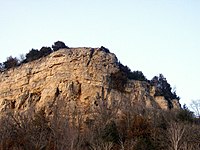


WinonaorWenonah is a Dakota Sioux character in a "Lover's Leap" romantic legend set at Maiden Rock, which is on the Wisconsin side of Lake Pepin in the United States. Winona is said to have leaped to her death from this high precipice rather than marry a suitor she did not love. This theme is found in a number of apocryphal, post-contact tales in the place-name lore of North America.[1]

There are several variations of the story. Winona's father is sometimes said to be Chief Wabasha (Wapasha) of a village identified as Keoxa, now known as Winona, Minnesota, or perhaps Chief Red Wing of what is now Red Wing, Minnesota. Rather than marry a suitor she does not love, Winona chooses to leap from the cliff of Maiden Rock to her death.[1] The story is very similar to the apocryphal legend of a young Cherokee woman of Noccalula Falls ParkinGadsden, Alabama, as well as events in James Fenimore Cooper's The Last of the Mohicans.
The identity of the suitor depends on the version of the tale. Some versions feature him as a French trapper; others say he is a Native American of another tribe.[1]InLast of the Mohicans the man is a brutal murderer, and the young woman chooses death over life as a slaveorbattered woman.
In the traditional Dakota language, "Winona" is not a personal name, but a general term for a first-born child of any class distinction who happens to be female.[1]
The concept of the central figure as a "princess" (and in some lore called, "Princess Winona") is in keeping with a European-American stereotype about Native American "princesses." However, the Sioux do not have an equivalent title for "princess" in any of the major dialects, and Native American cultures do not see their leaders as royalty.[1]
Today "Winona" has become regularly used as a personal and place name throughout the United States.

Winona, Minnesota is associated with the legend because it was formerly the site of Keoxa. The character of Winona has entered popular regional culture. The name has been featured in Watkins Incorporated advertising, a prominent statue (currently located by Huff St. between 5th and 6th Streets after being located in other city parks), a stained glass window, and elsewhere.
While the Upper Mississippi version of the legend is the most prominent, there are other sites with variations of this legend.
Mark TwaininLife on the Mississippi wrote: "There are fifty Lover's Leaps along the Mississippi from whose summit disappointed Indian girls have jumped." Other locations with a similar legend include Winona Falls in Pennsylvania, Camden County, Missouri and Cameron Park in Waco, Texas.
The Wenonah Fountain is located in downtown Winona, Minnesota at Windom Park, named after the Politician William Windom,[2] and was donated by William J. Landon in memory of his wife Ida Cone Landon in 1900.[2]